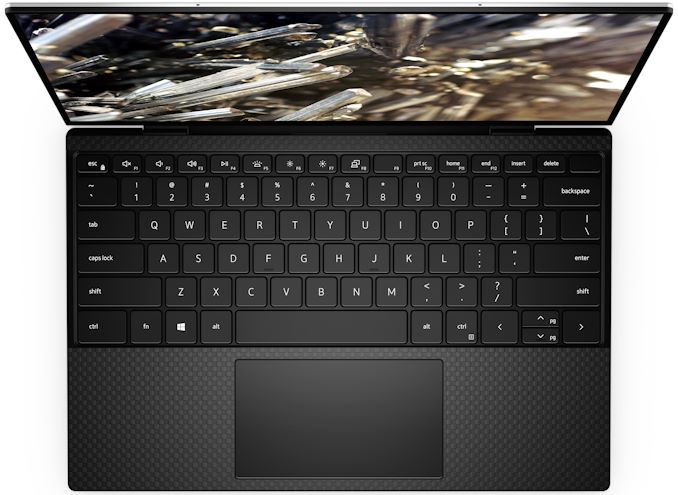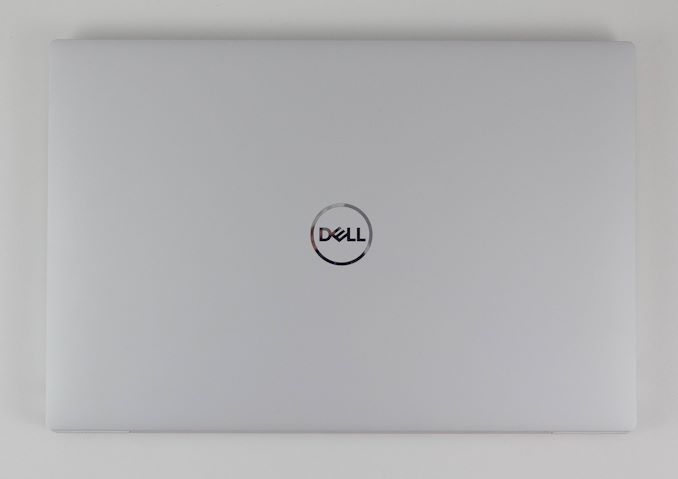The Dell XPS 13 (9300) Review: Return of the King
by Brett Howse on July 16, 2020 10:00 AM ESTDesign
Dell pioneered the thin-bezel laptop, but that does not mean they did not have room to improve on their original design over the years. The first several generations featured a webcam at the bottom of the panel, which was flattering to no one. With the proliferation of video chat, such a decision would be a major negative to many people. But thankfully Dell solved that particular issue a couple of generations ago, and the new model continues to pack a 720p webcam in the correct location above the display, with only a slightly taller top display bezel to accommodate the camera. And speaking of the display bezel, Dell has tweaked their design language slightly over the XPS 13 2-in-1, with both the black and white models both featuring a black display bezel on the clamshell XPS 13, which helps it disappear into the background a bit easier than the white bezel on the 2-in-1.

The XPS 13 in Platinum Silver with black carbon fiber
Another nice change over the 2-in-1 version is that Dell is not using their MagLev keyboard design, instead outfitting the XPS 13 with a more traditional scissor-switch keyboard with 1.0 mm of travel. The MagLev has a very short throw, whereas I find the traditional keyboard to be much more reassuring to use.
Dell is offering the XPS 13 in the same color choices as the 2-in-1 as well. The Platinum Silver model features a black carbon fiber keyboard deck with a soft-touch coating, while the Arctic White model features a woven fiber keyboard deck which Dell has treated with a stain and UV resistant coating, to prevent the deck from yellowing with age. The Arctic White is only $49 more, and certainly makes a statement, although it still suffers from the same issue as all white-on-white laptops with white backlighting, which is that the keyboard backlighting can wash out the keys in a bright room. That is a fairly minor negative though, for an otherwise fantastic finish.
The XPS 13 also features an excellent trackpad, offering a very smooth finish, and good precision. Laptop trackpads have come a long way, and part of that is the standardization on the Microsoft Precision touchpad drivers, which Dell employs here.
Dell has eschewed the use of USB Type-A ports, instead offering just a single USB Type-C port on each side of the laptop. This in turn is paired with a 3.5 mm headset jack on the right, and a micro SD card reader on the left. Although the XPS 13 lacks ports in numbers, it somewhat makes up for that with both USB ports supporting Thunderbolt 3, including power delivery. It is unfortunate that the Type-C port has found itself to be so confusing in its capabilities, but with the XPS 13 supporting the full range of protocols, as well as four lanes of PCIe on both ports, that at least is not a liability here. Dell does include a Type-C to Type-A adapter in the box as well, for those that require the larger port. By including power delivery on both sides of the laptop, that also means the XPS 13 can charge on either side, which can be very handy when moving the laptop from place to place.
Dell’s design ethos with their XPS lineup has converged across the entire range of XPS laptops, and with great success. The CNC milled aluminum bodies, thin bezels, compact designs, and lightweight chassis make for some of the most compelling devices in the industry. Moving to a 16:10 aspect ration on their XPS line has been yet another design win for Dell, and helps provide the excellent 91.5% screen to body ratio found on this XPS 13 notebook by further shrinking the bottom bezel. Dell has sculpted a clean, sleek, and functional device, and while the rest of the industry has also adopted the thin-bezel design, Dell has really mastered it.













224 Comments
View All Comments
gescom - Friday, July 17, 2020 - link
You have a kind of sick desperation in your laugh.https://www.notebookcheck.net/Lenovo-ThinkPad-T14s...
Korguz - Friday, July 17, 2020 - link
gescom, more like a sick desperation to keep praising his god intel, and to bash amd any chance he can.ikjadoon - Thursday, July 16, 2020 - link
IIRC, this was not mentioned by Anandtech, but this laptop (and many, many, many, many) others from the premium Ultrabook category are partnered directly with Intel through the Project Athena program, aka the "Engineered for Mobile Performance" badge you sometimes see.It gives a lot of manufacturing / R&D support while also demanding a minimum set of specifications; I think, in the end, it's a win for OEMs as they get a better product (a virtuous cycle) and they get R&D support directly from Intel on the entire notebook (not just the CPU or wireless).
I think 9/10 premium Ultrabooks are Project Athena certified.
I do believe AMD has launched a rival program with Renoir, but it may take time to gain traction. Tiger Lake vs Zen3-based mobile is going to be exciting and AMD absolutely deserves far better than the relatively average performers they keep getting stuck with.
See Anandtech's reporting here: https://www.anandtech.com/show/14444/intels-projec...
TheinsanegamerN - Thursday, July 16, 2020 - link
I've said for years that AMD needs to partner with a smaller brand like MSI or Clevo and show the world what a proper AMD notebook looks like.I was saying this back in the Llano days where nobody wanted to make a ultrabook style laptop with the A8-3500mx.
jeremyshaw - Thursday, July 16, 2020 - link
They did, with HP, a company with historically strong AMD ties in their consumer line. It didn't go well. Whomever thought bulldozer on netbooks was a good idea, is hopefully no longer calling shots at AMD or HP anymore.eastcoast_pete - Thursday, July 16, 2020 - link
I made the mistake of buying one, and it was bad. The sooner that whole period is buried and forgotten, the better for AMD.lmcd - Thursday, July 16, 2020 - link
If you're referring to the entire Bulldozer family history, I gotta say my Toshiba Satellite with an A8-4500M was actually pretty solid for a number of years. Yea the battery life was trash but performance held up for years, especially with dual-channel memory that I upgraded it to.drothgery - Thursday, July 16, 2020 - link
Depends what they think AMD and Intel will be offering next year, I'd imagine.Most vendors wouldn't have even started designing an AMD premium notebook until after they had real performance and power usage data on Ryzen 4xxx, and even then wouldn't bother unless they were fairly confident Intel wouldn't be able to match it fairly soon.
Cinebench multithread (and other embarrassingly parallel benchmarks) notwithstanding, there's really not much value in more than 4 core/8 threads for most consumers (servers and workstations are another matter); Amdhal's law is still real. But the optics of selling 4 cores vs 8 aren't great, and at least initially, Tiger Lake U will still be a quad core.
Spunjji - Friday, July 17, 2020 - link
"Most vendors wouldn't have even started designing an AMD premium notebook until after they had real performance and power usage data on Ryzen 4xxx"They would have had that data a long time before the platform shipped - Asus couldn't have designed the class-redefining Zephyrus 14 without it. They managed to create a whole new category of gaming sub-notebook, yet most of the larger OEMs couldn't manage to get one into an existing Ultrabook chassis. 🤔
Deicidium369 - Friday, July 17, 2020 - link
Yeah agree there - the OEMs have had access to the specifics of Renoir - but likely will repurpose previous designs, since Renoir is largely like the previous (3xxx APUs, don't know the names) - from an electrical and packaging point of view.I can't imagine having a laptop as a gaming platform - Opus Magnum maybe - but not BF5. But every use case is different - there used to be a DTR slot in my lineup - but not any more.